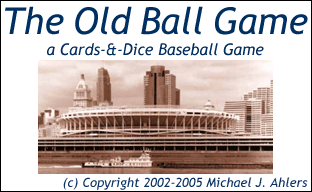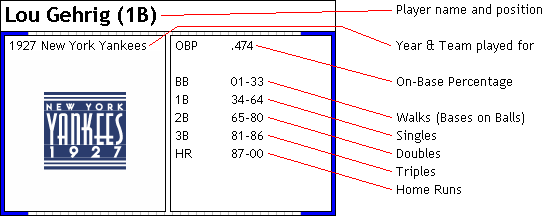

Introduction
Baseball. The National Game. Our National Pastime. The Old Ball Game. By any name, baseball is the sport that captured the imagination of the American public over one hundred years ago, and still does so today.
"The Old Ball Game" is a cards and dice baseball simulation that attempts to capture the thrill of the game, as well as pay homage to the men (and women) who've played the game.
What You Need to Play
To play, you will need two decks of "The Old Ball Game" cards, two 10-sided dice, and paper and pencil to keep track of innings, outs, and baserunners.
The Old Ball Game cards: Each deck contains a Team card and nine or more Player cards. For each team select nine Player cards; a 1st Baseman, a 2nd Baseman, a Shortstop, a 3rd Baseman, a Left Fielder, a Center Fielder, a Right Fielder, a Catcher, and a Pitcher. Set the remaining cards aside.
Player cards: Cards list the Player's name, sometimes his jersey number, his Team, the Year from which his statistics were taken, his On-Base Percentage, and an On-Base-Outcome table with the probabilities for bases on balls (walks), singles, doubles, triples, and home runs.
Two 10-sided dice (percentage dice): The two dice should be different colors, for example red and blue. One (we'll say red) is read as the tens place, and the other (blue in this example) is the ones place. Thus if you roll a 6 of the red die and 8 on the blue die, the result is read as 68. Double-zeros is read as 100.
Game Play
Sequence of Play: For each Batter, roll the percentage dice and compare the result to the first two digits of the Batter's On Base Percentage (OBP). If the roll is less than or equal to his OBP, then he has gotten on base. If the roll is higher, then the Batter is out. If the Batter did get on base, then roll the percentage dice again and compare the result to the Batter's On Base Outcome table to see if he has been walked (BB), or hit a single (1B), double (2B), triple (3B), or home run (HR). Make a note of what the Batter did, then flip his card face-down in another pile. Just as in real Baseball, three outs retires a side and brings the other team up to bat, and the games run nine innings (unless tied at the end of the ninth, sending the game into extra innings).
Sample Player Card

Here is Lou Gehrig's Player card. He played First Base (1B) for the 1927 New York Yankees. His On-Base Percentage (OBP) for that year was .474, meaning that for every one hundred times he stepped to the plate, he got on base (approximately) 47 times. The table shows his "on-base outcome" and is based on his actual statistics for that year. It shows the likelihood that he was walked (BB - Base on Balls), hit a Single (1B), a Double (2B), a Triple (3B), or a Home Run (HR).
Player Position abbreviations
1B - First Baseman
2B - Second Baseman
SS - Shortstop
3B - Third Baseman
LF - Left Fielder
CF - Center Fielder
RF - Right Fielder
C - Catcher
P - Pitcher
UT - Utility Player (substitute for any position except Pitcher)
DH - Designated Hitter (hits in place of the Pitcher)
Credits
Game Design & Development: Michael J. Ahlers.
Playtesters: John Ahlers, Jacob Cunningham, Joshua Cunningham, Susan Kester-Wilkins.
Resources
Major League Baseball
Total Baseball (7th Edition) - statistics from 1871-2000
www.baseball-almanac.com
www.baseball-reference.com
Women's Major League Baseball
The All-American Girls Professional Baseball League Record Book
Negro Leagues
The Complete Book of Baseball's Negro Leagues: The Other Half of Baseball History
The Negro Leagues Book
Only the Ball Was White